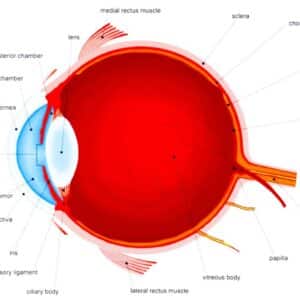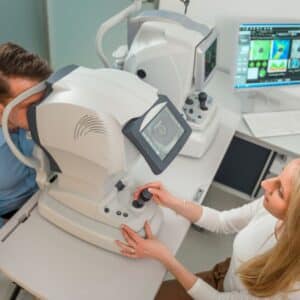Is it time to visit an optometrist? You rely on your eyesight every day, so it’s important to pay attention to any changes or issues that may arise. This article will discuss the top five signs that it’s time to schedule an appointment with an optometrist.
Whether you’re experiencing blurry vision, frequent headaches, or difficulty reading, these signs may indicate an underlying eye condition that needs to be addressed.
By addressing these issues promptly, you can prevent further damage to your eyes and improve your overall quality of life. So don’t ignore those warning signs – read on to find out when it’s time to see an optometrist and take proactive steps toward maintaining healthy vision.
Common Eye Conditions and Symptoms
Here are some common eye conditions along with their symptoms:
- Symptoms: Difficulty seeing objects at a distance, squinting, headaches, eyestrain.
- Description: Nearsighted individuals can see nearby objects clearly but have trouble focusing on distant objects.
- Symptoms: Blurred vision when looking at close objects, eyestrain, headaches.
- Description: Farsighted individuals have a clearer vision for distant objects but may struggle to focus on close-up tasks.
- Symptoms: Blurred or distorted vision at all distances, eye discomfort.
- Description: Astigmatism occurs due to an uneven corneal shape, leading to distorted and blurred vision.
- Symptoms: Difficulty focusing on close objects, needing to hold reading material farther away.
- Description: Presbyopia is an age-related condition causing a gradual loss of the eye’s ability to focus on nearby objects.
- Symptoms: Seeing two images of a single object, which may be side by side or stacked.
- Description: Double vision can result from problems with eye alignment, muscles, or nerve disorders.
- Symptoms: Difficulty distinguishing certain colors or shades.
- Description: Color blindness is a genetic condition where individuals have difficulty perceiving specific colors.
- Symptoms: Dry, irritated, red, or watery eyes, a gritty sensation, and sensitivity to light.
- Description: Dry eye occurs when tears are inadequate or of poor quality, leading to discomfort and vision problems.
- Symptoms: Redness, itching, burning, discharge, watery eyes.
- Description: Conjunctivitis is inflammation of the conjunctiva (the clear tissue covering the eye’s white part and the eyelids’ inner surface).
- Symptoms: Gradual loss of peripheral vision, tunnel vision, halos around lights, and eye pain (in acute cases).
- Description: Glaucoma is a group of eye conditions that damage the optic nerve, often caused by increased intraocular pressure.
- Symptoms: Blurred, cloudy, or dimmed vision, sensitivity to glare, poor night vision.
- Description: Cataracts involve the clouding of the eye’s natural lens, leading to decreased vision quality.
- Symptoms: Blurred or distorted central vision, difficulty reading, dark or empty areas in central vision.
- Description: Macular degeneration affects the central part of the retina (macula), leading to vision loss.
- Symptoms: Headaches, tired or aching eyes, difficulty focusing, dry eyes.
- Description: Eye strain often results from prolonged screen time, reading, or other activities requiring intense visual concentration.
If you experience any persistent or concerning symptoms related to your eyes or vision, you must consult an eye care professional for proper diagnosis and treatment.
The Top 5 Signs that Indicate a Need for an Optometrist Visit
Here are the top 5 signs that indicate a need for a visit to an optometrist:
Blurred or Distorted Vision:
- If you notice a sudden or gradual decrease in the clarity of your vision, whether it’s difficulty seeing objects up close, far away, or at any distance, it’s a clear signal to schedule an appointment with an optometrist. Blurred or distorted vision could indicate refractive errors, such as nearsightedness, farsightedness, or astigmatism.
Eye Discomfort or Pain:
- Persistent eye discomfort, pain, or a sensation of pressure could indicate various underlying issues. It might be related to dry eye, eye strain, conjunctivitis, or even more serious conditions like glaucoma. Any unusual and ongoing discomfort in your eyes should prompt a visit to an optometrist.
Changes in Peripheral Vision:
- If you notice a loss of side vision, suddenly see halos around lights or experience tunnel vision, it could be a sign of glaucoma or other serious eye conditions. These changes in peripheral vision warrant immediate attention from an optometrist.
Flashes of Light or Floaters:
- The sudden appearance of light flashes or a shower of floaters (specks or spots that seem to float across your field of vision) could indicate a retina detachment. This is a medical emergency; you should urgently see an optometrist or ophthalmologist.
Sudden Changes in Eye Appearance or Color:
- If you notice a change in the appearance of your eyes, such as redness, swelling, discharge, or any sudden change in eye color, it could indicate an infection, inflammation, or another underlying issue. These changes should be addressed and require professional evaluation.
Even if you’re not experiencing any specific signs, it’s important to schedule regular eye exams with an optometrist, especially as you age or if you have a history of eye problems. Routine check-ups can help detect and address potential issues before they become more serious.
The Role Of An Optometrist In Diagnosing And Treating Eye Conditions
Optometrists, as specialized healthcare providers, play a vital and multifaceted role in safeguarding the health of your eyes and preserving optimal vision. Their expertise encompasses diagnosing, treating, and managing various eye conditions. Below, we delve into the comprehensive role optometrists play in ensuring the well-being of your eyesight.
- Comprehensive Eye Examinations:
Optometrists are proficient in conducting thorough eye examinations, which is essential for detecting early signs of various eye conditions. These examinations include a variety of tests to assess visual acuity, depth perception, color vision, peripheral vision, and more. Optometrists can identify abnormalities or changes in your eye health through these exams.
- Refractive Error Correction:
One of the primary roles of an optometrist is to diagnose and correct refractive errors such as nearsightedness, farsightedness, and astigmatism. Following a precise assessment, optometrists prescribe corrective measures such as eyeglasses or contact lenses to optimize your visual clarity.
- Prescribing and Fitting Contact Lenses:
Optometrists are experts in determining the appropriate type and fit of contact lenses based on individual eye characteristics. They guide patients through proper insertion, removal, and care of contact lenses to ensure comfortable and effective use.
- Diagnosis and Treatment of Eye Diseases:
Optometrists can diagnose and manage a spectrum of eye diseases, including conjunctivitis (pink eye), dry eye syndrome, and eye infections. They also identify and monitor chronic conditions such as glaucoma, cataracts, and macular degeneration, providing early intervention and treatment to prevent progression.
- Management of Chronic Eye Conditions:
Optometrists work closely with patients with chronic eye conditions to develop personalized management plans. This may involve recommending lifestyle changes, prescribing medications, or coordinating with other healthcare professionals for specialized care.
- Monitoring and Follow-up Care:
Optometrists continuously monitor patients’ eye health, tracking changes over time. This proactive approach allows for prompt adjustments to treatment plans and interventions when necessary.
- Referral to Ophthalmologists:
In cases where advanced medical or surgical interventions are required, optometrists refer patients to ophthalmologists—medical doctors specialized in eye surgery and complex eye conditions. Optometrists collaborate with ophthalmologists to ensure comprehensive care for patients.
- Patient Education:
Optometrists are crucial in educating patients about maintaining eye health, recognizing potential issues, and practicing good eye hygiene. Through these efforts, they empower patients to take an active role in preserving their vision.
- Low Vision Rehabilitation:
Optometrists provide support and solutions for individuals with low vision, helping them maximize their remaining vision through specialized aids and techniques.
- Advancements in Technology:
Optometrists stay updated with advancements in eye care technology, allowing them to offer their patients the latest diagnostic tools and treatments.
Optometrists are frontline guardians of your eye health, offering comprehensive services ranging from routine eye exams to diagnosing and managing complex eye conditions. Their expertise ensures that your eyes receive the attentive care they deserve, helping you maintain clear and healthy vision.
The Importance Of Early Detection And Treatment
Maintaining healthy vision is integral to your overall well-being, and early detection and treatment of eye conditions play a pivotal role in ensuring optimal eye health. Timely intervention preserves your eyesight and mitigates the potential impact of various eye-related issues. Here’s why early detection and treatment are of paramount importance in the realm of eye care:
Preventing Progression:
When left untreated, many eye conditions can worsen over time. Timely detection enables healthcare providers to initiate appropriate treatments, preventing the advancement of conditions that could lead to permanent vision impairment or even blindness.
Maximizing Treatment Effectiveness:
Early intervention often results in more effective treatment outcomes. Whether it’s managing chronic conditions or addressing acute issues, initiating treatment at an early stage enhances the chances of a successful and positive response to interventions.
Preserving Quality of Life:
Clear and comfortable vision significantly improves your quality of life. Early treatment ensures you can continue performing daily tasks, enjoy recreational activities, and engage in personal and professional pursuits.
Preventing Further Complications:
If left untreated, some eye conditions can lead to secondary complications that extend beyond the eyes. For instance, uncontrolled diabetes can result in diabetic retinopathy, potentially leading to vision loss. Early treatment of the underlying condition and its associated eye issues can prevent systemic complications.
Minimizing Discomfort and Pain:
Prompt treatment can alleviate discomfort and pain associated with various eye conditions. Whether addressing eye infections, dry eyes, or corneal abrasions, early intervention can relieve and prevent unnecessary suffering.
Addressing Hidden Conditions:
Certain eye conditions, such as glaucoma or macular degeneration, may not exhibit noticeable symptoms in their early stages. Regular eye exams facilitate the detection of these hidden conditions before they progress to more advanced and irreversible stages.
Lowering Healthcare Costs:
Early detection and treatment can lead to cost savings in the long run. Treating eye conditions early reduces the need for more complex and expensive interventions that might be required if conditions are left untreated and allowed to progress.
Improving Long-Term Prognosis:
Early treatment increases the likelihood of a positive long-term prognosis for various eye conditions. Conditions that are caught and managed in their early phases are less likely to cause severe vision impairment or irreversible damage.
Enhancing Safety and Functionality:
Clear vision is essential for safe navigation and optimal functionality in daily life. Early treatment ensures that your eyes remain in the best possible condition to help you drive, work, and engage in activities without compromising safety.
Empowering Patient Well-being:
Early detection gives patients knowledge and control over their eye health. Being proactive about eye care and seeking timely treatment contributes to well-being and peace of mind.
Early detection and treatment in eye care are critical for preserving and optimizing your vision. Regular eye exams, attentive self-awareness, and prompt consultation with an eye care professional when symptoms arise are fundamental to maintaining healthy eyes and a higher quality of life. Remember, your eyes are precious – invest in their care today for a brighter and clearer tomorrow.
Tips For Finding a Reputable Optometrist in Your Area:
Selecting the right optometrist is crucial to maintaining healthy eyes and clear vision. Here are valuable tips to guide you in finding a reputable optometrist in your area:
- Ask for Recommendations: Seek recommendations from friends, family, or your primary care physician for reputable optometrists.
- Check Credentials: Ensure the optometrist is licensed and board-certified. You can verify their credentials through your state’s optometry board.
- Read Online Reviews: Look for reviews and ratings on reputable platforms to gauge patient experiences and satisfaction.
- Inquire About Specializations: If you have specific eye concerns, ask if the optometrist specializes in treating those conditions.
- Visit Their Website: A professional website often provides insights into the optometrist’s services, expertise, and practice philosophy.
- Visit the Clinic: Schedule a visit to the optometrist’s clinic to observe the facility’s cleanliness, organization, and professionalism.
- Check Insurance Coverage: Confirm if the optometrist accepts your insurance plan to minimize out-of-pocket expenses.
What to Expect During Your Optometrist Visit
A visit to the optometrist is a proactive step towards maintaining clear vision and optimal eye health. Here’s a comprehensive look at what you can expect during your optometrist visit:
- Health History: You’ll be asked about your medical history, family history, and current medications.
- Visual Acuity Test: You’ll read letters from an eye chart to assess your visual clarity.
- Refraction Test: This helps determine your eyeglass or contact lens prescription.
- Eye Health Examination: The optometrist examines your eyes’ structures using specialized tools and may dilate your pupils for a clearer retina view.
- Intraocular Pressure Test: This measures the pressure within your eyes to screen for glaucoma.
- Additional Tests: Depending on your needs, other tests like color vision, depth perception, and peripheral vision assessments may be conducted.
Different Types of Eye Exams and Tests:
The field of eye care offers a range of specialized exams and tests designed to address diverse visual needs and detect potential issues. Here’s an overview of the different types of eye exams and tests available:
- Comprehensive Eye Exam: A thorough assessment of your visual acuity, eye health, and potential eye diseases.
- Pediatric Eye Exam: Specialized exams to detect and manage vision issues early for children.
- Contact Lens Exam: Evaluate your suitability for contact lenses, determine the correct fit, and provide instructions on care.
- Low Vision Exam: Assesses visual impairment and recommends aids to enhance remaining vision.
- Specialty Exams: Tailored for specific conditions like diabetic eye exams, dry eye assessments, or sports vision evaluations.
Treatment Options for Common Eye Conditions:
When facing common eye conditions, understanding your treatment options is essential for making informed decisions about your eye care. Here are some of the treatment options available for frequently encountered eye conditions
- Refractive Errors: Corrected with eyeglasses, contact lenses, or refractive surgery like LASIK.
- Dry Eye Syndrome: Management includes artificial tears, lifestyle changes, and prescription medications.
- Glaucoma: Treated with eye drops, oral medications, or surgery to reduce intraocular pressure.
- Cataracts: Surgical removal and replacement with an intraocular lens implant.
- Macular Degeneration: Treatment may involve injections, laser therapy, or medications.
- Conjunctivitis: Treatment depends on the cause, from prescription eye drops to warm compresses.
- Allergies: Managed with antihistamine eye drops, avoidance of allergens, and other medications.
Your optometrist is a valuable resource for information and guidance. They will tailor your eye care plan based on your needs, ensuring you receive the best treatment and maintain optimal eye health.
Conclusion
Recognizing the signs that warrant a visit to an optometrist is pivotal for safeguarding your eye health and maintaining optimal vision. You can ensure timely care and early intervention by staying attentive to changes in your eyesight and addressing any issues promptly.
Your eyes play a vital role in your daily life, and seeking professional guidance from an optometrist can make a significant difference in preserving the clarity and well-being of your vision.
Making regular eye check-ups a priority and addressing any concerns promptly can help you enjoy clear vision and visual comfort.






